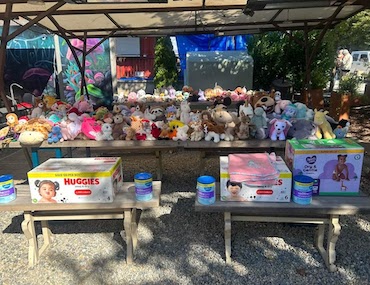Across the globe, hurricanes and other weather-related emergencies are increasing in frequency, and our youngest children are one of the most vulnerable populations in the aftermath of such natural disasters.
To help children ages 0–5 make sense of their experiences and rebuild a sense of security after a major storm, research-based interventions, such as opportunities to process events through play, can provide essential support for children’s brain development and emotional recovery as they cope with the trauma.
 Following the devastation of Hurricane Helene in September, Gabriel Guyton, Co-Director of the Center for Emotionally Responsive Practice at Bank Street College, and a resident of Asheville, North Carolina, quickly leveraged her expertise as a mental health specialist and educator to facilitate spaces for healing by creating a temporary playgroup for children and families in her community.
Following the devastation of Hurricane Helene in September, Gabriel Guyton, Co-Director of the Center for Emotionally Responsive Practice at Bank Street College, and a resident of Asheville, North Carolina, quickly leveraged her expertise as a mental health specialist and educator to facilitate spaces for healing by creating a temporary playgroup for children and families in her community.
The playgroup is designed to offer a safe, emotionally responsive area for young children to process the grief, fear, and overwhelm that often accompany natural disasters. Guyton’s makeshift play space—set up in her living room—includes materials that encourage children to make sense of what has happened through play. This includes items commonly seen in the disaster zone like rain boots, water bottles, and pillows shaped like tree stumps for children to act out recent experiences.
“We know the power of play and how important it is for healing, but we are trying to be very intentional,” said Guyton, describing how the space includes carefully selected materials and access to nurturing adults who understand child development and learning. “A space like this can help children experience hard emotions like sadness, fear, and anger within a safe environment that also allows them to recreate new imaginative worlds and find places for hope.”
In the play space, children can use blocks and magnetic tiles to build structures that they knock down and then rebuild, fostering resilience and problem-solving skills. Additionally, age-appropriate books and songs, such as The Rabbit Listened and “The Itsy-Bitsy Spider,” help children learn to understand concepts of loss and recovery.
 A cornerstone of the Center for Emotionally Responsive Practice’s approach, children also have access to transitional objects like stuffed toys or teddy bears. These items offer children emotional support, provide comfort, and create a sense of security.
A cornerstone of the Center for Emotionally Responsive Practice’s approach, children also have access to transitional objects like stuffed toys or teddy bears. These items offer children emotional support, provide comfort, and create a sense of security.
In addition, Guyton has made essential supplies available to anyone in need, including food, water, and diapers, and plans to offer winter coats in the coming weeks as well.
As communities respond to the long-term mental health impacts of natural disasters, a recent Medium piece authored by Jessica Charles, Associate Dean for Research and Innovation, Bank Street Graduate School of Education, and Margaret Blachly, GSE ’05, Co-Director of the Center for Emotionally Responsive Practice at Bank Street College, highlights the urgent need for additional funding in emergency disaster relief for children. Funding for spaces like the one Guyton created for her neighbors is not systematically available to those experiencing these crises but can provide critical support.
Charles and Blachly explain in the article, “These efforts require relatively modest investments, yet stand to offer some of the greatest yields we can make in communities that are coping with the trauma of natural disasters.”
The Center for Emotionally Responsive Practice helps support the mental health and well-being of children and adults in schools and other programs through professional development, coaching, and various services. To learn more, view our digital brochure (pdf) or visit our webpage.